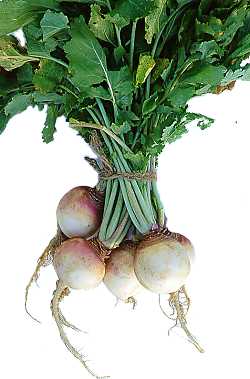|
Brassica rapa
(Turnip, Rapes, Mustards, Oriental cabbages)
[= Brassica campestris] Life
> eukaryotes >
Archaeoplastida >
Chloroplastida
>
Charophyta > Streptophytina > Plantae (land plants)
> Tracheophyta (vascular plants) > Euphyllophyta > Lignophyta (woody plants)
> Spermatophyta (seed plants) > Angiospermae (flowering
plants) > Eudicotyledons > Core Eudicots > Rosids >
Eurosid II > Order: Brassicales > Family: Brassicaceae > Genus:
Brassica

Native to Europe and Asia and grown from at least 3500
years ago as an oilseed crop in India. Turnips were first grown in Europe and
cabbage-like varieties were developed in the Far East.
The wild form of this species is native to Europe and
Asia and has slender roots.It has been a weed of cereal crops since the start of
agriculture in the Neolithic period. It was domesticated at an early date,
independently in different regions. As far back as at least 1500 BC it was being
grown as an oilseed crop (= Rape) in India and this has continued in this
country up to the present day. In Roman times, the Gauls and other
European groups were growing Turnip (a variety of Brassica rapa
with a swollen root that is eaten cooked at a vegetable) and it had probably
been grown as a vegetable in this region well before this time. Turnips were
also grown for feeding livestock. In the Far East, B. rapa has been
grown mainly as a leafy vegetable and two important cultivars include Chinese
Celery Cabbage and Chinese White Cabbage. As with Brassica oleracea in
Europe, B. rapa was very important to the Chinese in surviving the
long winters: they either kept it fresh for as long as possible or pickled it.
References
CRC Press, Boca Raton, Florida.
Text by Hamish Robertson
|
